
 |
||||||||
|
|
||||||||
Renaissance
Martial Arts Literature
|
|
"Princes
and Lords learn to survive with this art, in earnest and in play. “So
from this art comes all sorts of good, with arms cities are subdued |
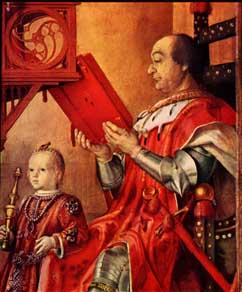 |
The little known surviving
treatises and guidebooks of fighting skills produced by European
authors are numerous and diverse.
Books and manuscripts on personal combat skills
flourished in the 15th and 16th
centuries. The
oldest known European fighting text is an anonymous German sword and
buckler manual (MS I.33) produced around c. 1295. Its watercolor pages
feature a series of images of a monk and his partner performing various
attacks and counter attacks and has recently come to be more
appreciated as a source for study of historical European martial arts. The writings of the great
Swabian master Johannes Liechtenauer in the 1380s were highly
influential among German masters for the next two centuries. His
teachings, as chronicled by by the priest and master-at-arms, Hanko
Doebringer, were expanded and written on by many others throughout the
1400s and early 1500s including Paulus Kal, Peter Falkner, Hans von
Speyer, Ludwig Von Eyb, Gregor Erhart, Sigmund Schining, Andre
Pauernfeindt, and others. A major one of these commentators was that of
Sigmund Ringeck in the 1450s and Peter Von Danzig in the 1450s. Among
their teachings, these Fechtbuchs (“fight books” or “fencing books”)
present a consistent emphasis on unarmored foot-combat with long-swords
that incorporate grappling techniques.
In
1410 the Bolognese master Fiore dei Liberi produced a systematic work,
Flos Duellatorium in Armis, which represents the major Italian
contribution to 15th century martial arts literature. Three
different editions of Fiore’s work survive and have become major
resources for modern students. The Fechtbuch
of Hans Talhoffer covering among other things, swordplay, judicial
combat, dagger fighting and wrestling was also influential. It was
produced in several versions from the 1440s to 1460s. Other important
fighting texts surviving from the 15th century include
works such as the Codex Wallerstein, the anonymous “Gladiatorie”
and “Goliath” manuscripts, as well as the Solothurner
Fechtbuch. There is also an anonymous 15th century work on the
use of the medieval pole-axe, Le Jeu de la Hache. The
King of Portugal, Dom Duarte,
produced several training texts in the 1420s.
While two obscure 15th century works on swordplay
from England also survive (the MS 3542 and MS 39564 documents).
Fabian von Auerswald also produced a detailed wrestling manuscript
about 1462, of which a well-illustrated later edition still exists.
Fillipo
Vadi in the 1480s produced another major Italian work on fighting
from the period, which was highly influenced by Fiore’s. The
Hispano-Italian knight Pietro Monte produced several tittles on fighting
and combat skills during the 1480s and ‘90s, including the first
published wrestling book. Hans Czynner produced an illustrated
color work of armored combat on the techniques of “half-swording”
and dagger fighting in armor. Hanns Wurm’s colorfully inked
manual, Das Ringersbuch, of c. 1500 features a range of illustrated
wrestling moves and is characteristic of unarmed texts of the period.
Around 1512 the artist Albrecht DŸrer produced a beautifully
and realistically drawn work illustrating sword and wrestling techniques.
Several versions of Jšrg Wilhalm’s work survive
including a large hand-written color 1523 edition featuring an array
of unarmored and armored long sword techniques.
About 1540 Paulus Hector Mair compiled an immense and a well-illustrated
tome on weapon arts including swords, staffs, daggers, and other weapons.
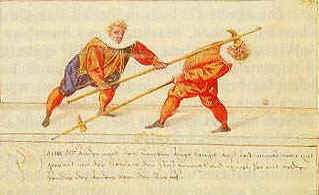 Di
Antonio Manciolino’s work of 1531 is the first known printed
Italian fencing manual. One of the more significant
masters of the 1500s was the Bolognese teacher Achille
Marrozo. His Opera Nova of 1536 is considered the first
text to emphasize the use of the thrust as well as the cut in using
a slender tapering single-hand blade. His work however still covered
the traditional military weapons of the age.
Di
Antonio Manciolino’s work of 1531 is the first known printed
Italian fencing manual. One of the more significant
masters of the 1500s was the Bolognese teacher Achille
Marrozo. His Opera Nova of 1536 is considered the first
text to emphasize the use of the thrust as well as the cut in using
a slender tapering single-hand blade. His work however still covered
the traditional military weapons of the age.
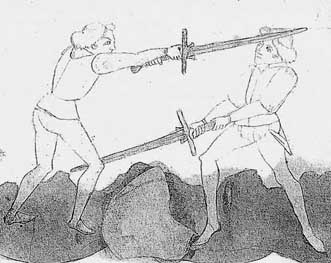 In
1548 the Spanish knight Juan Quixada de Reayo produced a little known
text on mounted combat that reflects traditional 15th century
methods. In 1550 the Florentine
master and contemporary of Marozzo, Francesco Altoni, wrote his own
fencing text that disputed some ideas of Marozzo.
Often attributed to the 1570s, Angelo Viggianni's significant
work of 1551, Lo Schermo, also focused
on the use of a long, slender, tapering single-hand sword.
Camillo Agrippa’s treatise on the science of arms
from 1553 was one of the first to focus on use of the thrust
over the cut in civilian swordplay. Considered another one of the
more significant Italian fencing works of the 1500s, Agrippa’s
treatise also represents the transition from military to civilian
swordplay and the use of even more narrow swords.
In
1548 the Spanish knight Juan Quixada de Reayo produced a little known
text on mounted combat that reflects traditional 15th century
methods. In 1550 the Florentine
master and contemporary of Marozzo, Francesco Altoni, wrote his own
fencing text that disputed some ideas of Marozzo.
Often attributed to the 1570s, Angelo Viggianni's significant
work of 1551, Lo Schermo, also focused
on the use of a long, slender, tapering single-hand sword.
Camillo Agrippa’s treatise on the science of arms
from 1553 was one of the first to focus on use of the thrust
over the cut in civilian swordplay. Considered another one of the
more significant Italian fencing works of the 1500s, Agrippa’s
treatise also represents the transition from military to civilian
swordplay and the use of even more narrow swords.
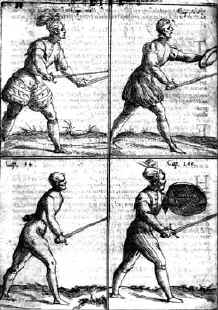 The
Dutch artist Martinus Heemskreck in 1552 illustrated a text, Fechten
& Ringen, with several woodcuts of short sword, two-handed
sword, and wrestling. The
German master Joachim Meyer in 1570 produced a large and extremely
well illustrated training manual that represents one of the high points
of 16th century works. The
work covered a host of assorted swords and weapons and combined some
Italian and German elements. Meyer included material on classroom
play as well as earnest self-defence. Jacob
Sutor later produced a fighting manual in 1612 that was mostly an
updated version of Meyer’s earlier work.
The
Dutch artist Martinus Heemskreck in 1552 illustrated a text, Fechten
& Ringen, with several woodcuts of short sword, two-handed
sword, and wrestling. The
German master Joachim Meyer in 1570 produced a large and extremely
well illustrated training manual that represents one of the high points
of 16th century works. The
work covered a host of assorted swords and weapons and combined some
Italian and German elements. Meyer included material on classroom
play as well as earnest self-defence. Jacob
Sutor later produced a fighting manual in 1612 that was mostly an
updated version of Meyer’s earlier work.
In 1570, Giacomo Di Grassi produced, His True Arte of Defense, a major work on fencing from the period that reveals elements of the changing nature of civilian self-defense concerns and the development of slender duelling swords. An English version was first translated in 1594. The Italian Girolamo Cavalcabo’s work of c.1580, concerned primarily with sword and dagger, was translated into German and French several times over the coming decades. In 1595 Vincentio Saviolo produced, His Practice in Two Books, one of the more influential (and today popular) of late Renaissance manuals. Saviolo’s method reflects the changing form of civilian blade in use. An English version of the text was influential at the time.
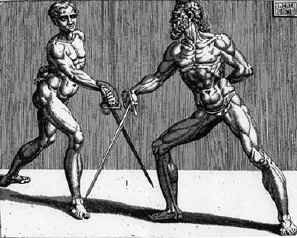 Giovanni
Antonio Lovino in 1580 produced a large and elaborate fencing treatise
on rapier as well as other swords and weapons. Until recently, only
limited portions of Lovino’s work were previously known.
Other important Italian fencing works of the late Renaissance
include those by the masters Giovanni Dell’Agochie in 1572,
Camillo Palladini from c. 1580, Alfonso Fallopia in 1584, Nicoletto
Giganti in 1606, Salvator Fabris also in 1606, and later Francesco
Alfieri in 1640. Nearly all these works
reflect the transition from military swords to the civilian duelling
rapiers. In 1610, the Ridolfo Capo Ferro’s,
Gran Simulacro, was first published. Considered
the great Italian master of the rapier and father of modern fencing,
his work codified much of civilian foyning fence for the duel. These
Italian fencing texts offer some of the best of illustrated examples
of rapier fencing.
Giovanni
Antonio Lovino in 1580 produced a large and elaborate fencing treatise
on rapier as well as other swords and weapons. Until recently, only
limited portions of Lovino’s work were previously known.
Other important Italian fencing works of the late Renaissance
include those by the masters Giovanni Dell’Agochie in 1572,
Camillo Palladini from c. 1580, Alfonso Fallopia in 1584, Nicoletto
Giganti in 1606, Salvator Fabris also in 1606, and later Francesco
Alfieri in 1640. Nearly all these works
reflect the transition from military swords to the civilian duelling
rapiers. In 1610, the Ridolfo Capo Ferro’s,
Gran Simulacro, was first published. Considered
the great Italian master of the rapier and father of modern fencing,
his work codified much of civilian foyning fence for the duel. These
Italian fencing texts offer some of the best of illustrated examples
of rapier fencing.
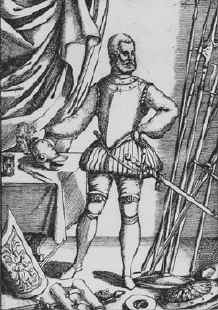 The
master Jeronimo De Carranza wrote his influential tome on Spanish
fencing, De La Philosophia de las Armas,
in 1569. It was to become one of two major Spanish fencing manuals
that formed the heart of the Spanish school for later centuries.
The other great Spanish master of the age was Don Luis P. de
Narvaez, who’s 1599, Libro de las Grandezas de la
Espada (“Book
of the Grandeur of the Sword”) presented rapier material somewhat
different than his master Carranza's. Narvaez’s book is the
other of only two major Spanish fencing manuals from the time. Several
Spanish masters during the 1600s produced fencing books rewriting
the teachings of Carranza or Narvaez and favouring one or the other.
In 1640,
Mendes de Carmona,
a fencing master from Seville,
produced his, Libro de la destreza berdadera
de las armas, an unpublished
manuscript recently discovered.
The
master Jeronimo De Carranza wrote his influential tome on Spanish
fencing, De La Philosophia de las Armas,
in 1569. It was to become one of two major Spanish fencing manuals
that formed the heart of the Spanish school for later centuries.
The other great Spanish master of the age was Don Luis P. de
Narvaez, who’s 1599, Libro de las Grandezas de la
Espada (“Book
of the Grandeur of the Sword”) presented rapier material somewhat
different than his master Carranza's. Narvaez’s book is the
other of only two major Spanish fencing manuals from the time. Several
Spanish masters during the 1600s produced fencing books rewriting
the teachings of Carranza or Narvaez and favouring one or the other.
In 1640,
Mendes de Carmona,
a fencing master from Seville,
produced his, Libro de la destreza berdadera
de las armas, an unpublished
manuscript recently discovered.
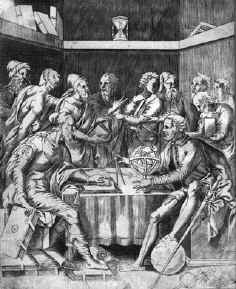 The
young Italian soldier and swordsman, Frederico Ghisliero, in 1587
produced an unpublished work, the Regole,
revealing connections to Spanish styles. About 1600 Don Pedro de Heredia
produced his, TraitŽ des Armes,
an illustrated color manuscript on rapier that included grappling
techniques. Heredia was a master-of-arms, cavalry captain and member
of the war council of the king of Spain. His work represents a pragmatic
Spanish style not wrapped in the geometrical ideas of Carranza and
Narvaez. Heredia’s manual is evidence the Spanish school was
neither uniform nor monolithic. Mendes
de Carmona’s, Libro
de la destreza berdadera de las armas, an unpublished manuscript
of 1640 has also recently been rediscovered. Carmona
was a fencing master in Seville, who previously wrote a work on Carranza’s
method. His previously unknown
work is a substantial manuscript covering the principles and fundamentals
of fencing and tactics to use in specific situations. The
most elaborate and lavishly illustrated Renaissance fencing text was
that of Girard Thibault d’Anvers', Academie De L'Espee
(c. 1630), written in French by a Flemish master teaching a version
of the Spanish rapier.
The only truly French
fencing texts known from the Renaissance are that of Henry de Sainct
Didier in 1573, Tracicte’ contenan les ecrets du premier
livre de l’espee seule,
and Francois Dancie wrote his L’espŽe de Combat,
in Tulle, in 1623.
The next known is Charles Besnard’s later, Le
Maitre d’arme Liberal,
of 1653.
The
young Italian soldier and swordsman, Frederico Ghisliero, in 1587
produced an unpublished work, the Regole,
revealing connections to Spanish styles. About 1600 Don Pedro de Heredia
produced his, TraitŽ des Armes,
an illustrated color manuscript on rapier that included grappling
techniques. Heredia was a master-of-arms, cavalry captain and member
of the war council of the king of Spain. His work represents a pragmatic
Spanish style not wrapped in the geometrical ideas of Carranza and
Narvaez. Heredia’s manual is evidence the Spanish school was
neither uniform nor monolithic. Mendes
de Carmona’s, Libro
de la destreza berdadera de las armas, an unpublished manuscript
of 1640 has also recently been rediscovered. Carmona
was a fencing master in Seville, who previously wrote a work on Carranza’s
method. His previously unknown
work is a substantial manuscript covering the principles and fundamentals
of fencing and tactics to use in specific situations. The
most elaborate and lavishly illustrated Renaissance fencing text was
that of Girard Thibault d’Anvers', Academie De L'Espee
(c. 1630), written in French by a Flemish master teaching a version
of the Spanish rapier.
The only truly French
fencing texts known from the Renaissance are that of Henry de Sainct
Didier in 1573, Tracicte’ contenan les ecrets du premier
livre de l’espee seule,
and Francois Dancie wrote his L’espŽe de Combat,
in Tulle, in 1623.
The next known is Charles Besnard’s later, Le
Maitre d’arme Liberal,
of 1653.
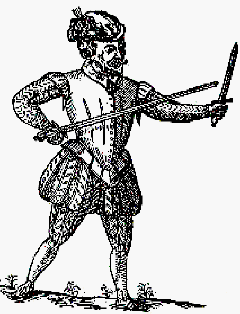 The
master George Silver published his Paradoxes of Defense defending
traditional English swordplay in 1599. He wrote his, Brief Instructions
Upon my Paradoxes of Defence, a year later. His work is the
primary source for information on English methods of martial arts
from the Renaissance and is a favorite study source for modern students
of historical fencing. Silver, a critic
of the rapier, pragmatically described the use of short sword or back-sword,
buckler, staff, and dagger. In 1614, George
Hale wrote, The Private Schoole of Defence, commenting on English
fighting schools of the day as well as recommendations on the rapier
method. In 1617 Joseph Swetnam wrote a
rapier and back sword treatise entitled, The Schoole of the Noble
and Worthy Science of Defence and in 1639 one “G. A.”
published a book on swordsmanship, Pallas Armata - The Gentleman's
Armory. It has been suggested that
the author was one, Gideon Ashwell. By 1650 the Marquise of Newcastle
wrote his own short treatise, The Truthe off the Sorde, a little-known
work based on the Spanish School.
The
master George Silver published his Paradoxes of Defense defending
traditional English swordplay in 1599. He wrote his, Brief Instructions
Upon my Paradoxes of Defence, a year later. His work is the
primary source for information on English methods of martial arts
from the Renaissance and is a favorite study source for modern students
of historical fencing. Silver, a critic
of the rapier, pragmatically described the use of short sword or back-sword,
buckler, staff, and dagger. In 1614, George
Hale wrote, The Private Schoole of Defence, commenting on English
fighting schools of the day as well as recommendations on the rapier
method. In 1617 Joseph Swetnam wrote a
rapier and back sword treatise entitled, The Schoole of the Noble
and Worthy Science of Defence and in 1639 one “G. A.”
published a book on swordsmanship, Pallas Armata - The Gentleman's
Armory. It has been suggested that
the author was one, Gideon Ashwell. By 1650 the Marquise of Newcastle
wrote his own short treatise, The Truthe off the Sorde, a little-known
work based on the Spanish School.
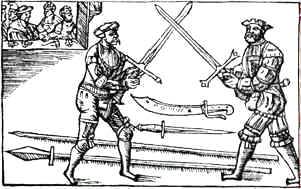 This
description of Renaissance martial arts literature is far from complete.
Many other fighting manuals were certainly produced in the 16th
and 17th centuries by a host of other masters and writers.
In 1620 for example, Hans Wilhelm Schšffer fashioned an
enormous work, Fechtkunst, that contained 672 crude rapier
illustrations each one fully described and annotated.
Other German fencing teachers in the early 1600s were
rewriting Italian texts.
This
description of Renaissance martial arts literature is far from complete.
Many other fighting manuals were certainly produced in the 16th
and 17th centuries by a host of other masters and writers.
In 1620 for example, Hans Wilhelm Schšffer fashioned an
enormous work, Fechtkunst, that contained 672 crude rapier
illustrations each one fully described and annotated.
Other German fencing teachers in the early 1600s were
rewriting Italian texts.
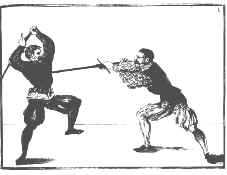 The
Dutchman, Johannes Georgius Pascha, in 1657 offered a rapier text
that included substantial material on the pike and unarmed combat.
Fencing works besides those focused on swords or wrestling
were also written during the Renaissance. For example, Andres
Legnitzer wrote on the spear in the early 1400s, while Ott Jud did
the same on wrestling and Hans LeckŸchner also made a treatise
on the Langen Messer (“large-knife”).
In 1603, the Italian, Lelio de Tedeschi,
produced a manual on the art of disarming while in 1616 the Spaniard
Atanasio de Ayala wrote a short text dealing with staff weapons
and Bonaventura Pistofilo’s Il Torneo,
Bologna 1627, was on the use of the polaxe.
Antonio Quintino’s 1613, “Jewels of Wisdom.”
included 16 pages of grappling and wrestling in swordplay as well
as material on animal fighting. Before
1620 Giovan' Battista Gaiani had also written two books on swordsmanship
for horseback.
The
Dutchman, Johannes Georgius Pascha, in 1657 offered a rapier text
that included substantial material on the pike and unarmed combat.
Fencing works besides those focused on swords or wrestling
were also written during the Renaissance. For example, Andres
Legnitzer wrote on the spear in the early 1400s, while Ott Jud did
the same on wrestling and Hans LeckŸchner also made a treatise
on the Langen Messer (“large-knife”).
In 1603, the Italian, Lelio de Tedeschi,
produced a manual on the art of disarming while in 1616 the Spaniard
Atanasio de Ayala wrote a short text dealing with staff weapons
and Bonaventura Pistofilo’s Il Torneo,
Bologna 1627, was on the use of the polaxe.
Antonio Quintino’s 1613, “Jewels of Wisdom.”
included 16 pages of grappling and wrestling in swordplay as well
as material on animal fighting. Before
1620 Giovan' Battista Gaiani had also written two books on swordsmanship
for horseback.
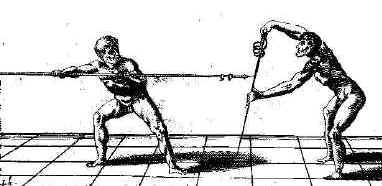
The teachings of these masters
do not appear to reflect a set "style" or a "Way" so much as a
systematic tradition of using proven and efficient techniques within a
sophisticated understanding of general fighting principles. Much of
what we know of these many guidebooks and fighting treatises is
changing and expanding. Although
just beginning, serious modern study and interpretation of Renaissance
martial arts literature is now well underway.
In addition to those described here, many other
martial arts manuals were known to have been produced, but existing
copies have yet to be found. Previously
unexamined collections that have recently become available and should
soon open up will inevitably bring to light even more source manuals. It is an exciting time for
research as the hunt for further Renaissance martial arts literature
continues.
View our original web documentary
series on
the Martial Arts of Renaissance Europe here:
See also Introduction to Historical European Martial Arts
and|
|
|||
|
|
|||
|
|||